As CES 2013 showed, the Chinese aren't coming – they're already here
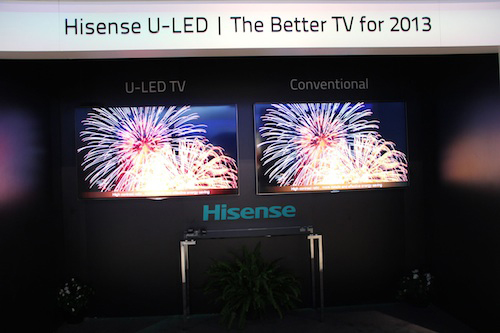
The TV landscape is changing.
From being the leaders – both in technology and sales – , big Japanese names such as Panasonic and Sony are in the unenviable position of playing catch-up to the new masters of the market, the South Korean giants LG and Samsung.
And while the Koreans have been involved in a slightly childish game of 'tit for tat' at CES 2013 – a friend suggested slightly mischievously that when LG announced its curved-screen OLED screen, some Samsung engineers were sent round the back of their massive stand with a TV and a hot air gun –. the Japanese attempts to stay on the ball had mixed fortunes.
Panasonic went for a massive range of TVs using existing technology, plus a late-announced OLED model, while Sony's 'big reveal' was a prototype OLED screen showing Windows rebooting messages – this when at least one of the Korean rivals was quoting (scary) prices and delivery dates for its OLED TV.
But behind all this posturing, there's an increasingly obvious spectre at the feast – and it's one threatening not only the Japanese majors' increasingly frantic attempts at TV division recovery, but also the ascendent Korean majors.

For not only are 'the Chinese coming', as the TV industry has been muttering in increasingly worried tones for some years now – they're here.
What were once slightly quirky companies – only spotted at the likes of the Hong Kong Electronics Fair, and with rather clunky LCD TVs alongside their My Little Pony- and High School Musical-branded CRT portable TVs and karaoke machines – are now mainstream players, ready to stake their claim on the global stage.
The latest hi-fi, home cinema and tech news, reviews, buying advice and deals, direct to your inbox.
Consumer electronics company Hisense made its presence very definitely felt at last week's CES 2013, taking the prime exhibition position once hogged by Microsoft to install its own enormous stand, with everything from 'smart' fridges to even smarter TVs, while rivals such as Haier not only have new product in depth, such as the TV above, but are proving they can mix it with the existing big boys when it comes to the latest TV tech.
OK, so Panasonic has recently announced it's scaling back its Chinese TV assembly operations with the closure of its Shanghai plasma plant, but as well as Chinese companies making TVs for, or with, some of the big established names – Philips springs immediately to mind, with its minority holding in a joint venture with TPV (below) now making its TVs for Europe – there are now clear signs that those same companies want to be seen as a force in their own right.

For example, both Haier and Hisense showed huge ranges of product at CES, from TVs all the way through to cooking and refrigeration appliances – in other words, the same kind of diversity previously the preserve of Panasonic, say. Or LG or Samsung, for that matter.
No shortage of ambition – and determination
But then there's no shortage of ambition in the way the Chinese companies are tackling things: Haier has its roots in a state-run refrigerator factory founded in the 1920s, has risen to be the world's largest maker of 'white goods' – fridges, washing machines and the like – with sales last year of around £14.5bn last year including a claimed 12m fridges, and 70,000 employees.
Its name comes from an earlier joint venture agreement with German high-end appliance company Liebherr – Haier is so much snappier than Qingdao Refrigerator Co, or indeed Qindao-Liebherr, and was taken from the Chinese version of the name – and by 2005 the company was confident enough to make a bid for major US appliance company Maytag. eventually losing out to Whirlpool.
Hisense, meanwhile, has similar roots in Qingdao, and is also state-run, although as with Haier there's an element of private enterprise in the operation. But while Hisense is growing to encompass a similar diversity of products, it's coming at the task from the opposite direction, having started out as Qingdao No.2 Radio Factory in the late 1960s, and been switched over to TV production at the beginning of the 1980s.
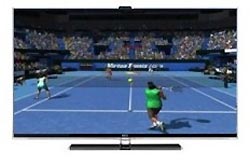
So what emerged at CES? Well, as well as matching the likes of Samsung when it comes to 3D, LED and the like (up to and including both Ultra HD and glasses-free 3D), Haier was showing it's no slouch when it comes to styling, with a 'virtually edgeless' display to give the 'sheet of glass' look (left).
And when it comes to advanced technology of the kind manufacturers like to trot out at event such as this, Haier of course had the gesture control and face recognition it had previously shown (below).
This is able to set up parameters such as favourite channels according to who's watching the set, and even respond to where on the screen you're looking.
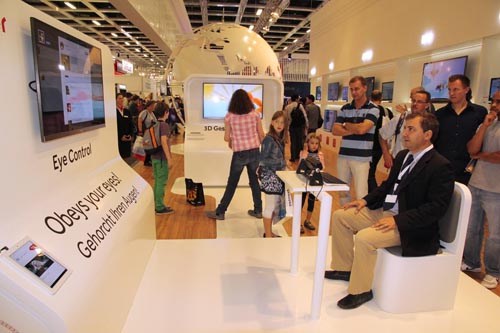

But it went one stage further, with brainwave control of the TV, using the MindReader headset (left) from Silicon Valley company NeuroSky.
Think of a channel you want to watch? Well, sort of – and the system also includes 'an assortment of specific concentration games designed to help children and adults practice their abilities to focus or relax'.
By the way, it may be worth noting that another product from NeuroSky is the Necomimi, a pair of wiggling cat ears on a headband controlled by your thoughts.
Available in a choice of ears (from Jungle Leopard to Minky Brown) plus Devil's Horns, the system is yours for just under $100 from www.necomini.com (US only so far, unfortunately).
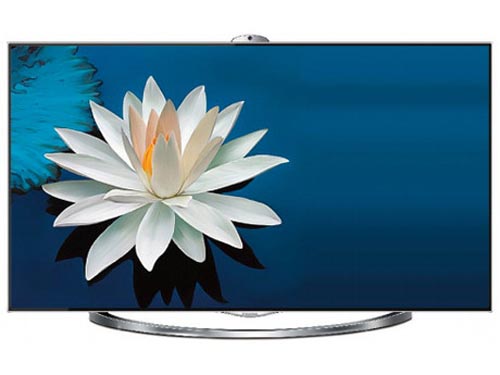
Back on topic, Hisense went for maximum impact with its 4K Ultra HD TV (above) – no less than a 110in model, though it will also be available in 65in and 84in versions.
The XT900 series will have Smart TV functionality with Wi-Fi built-in, active shutter 3D capability, and a USB-mounted detachable camera usable for Skyping as well as gesture control and facial recognition. In addition the handset has a microphone, enabling voice control.
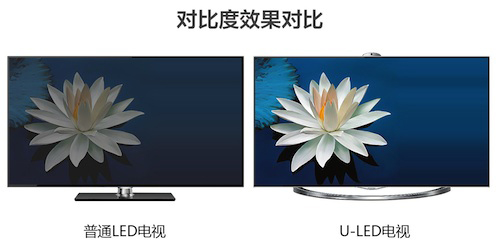
As if all that wasn't enough, the company is claiming 10m:1 dynamic contrast for the XT900 models, thanks to U-LED (or Ultra-LED) technology, using software and hardware optimisation to deliver better contrast, wider colour gamut and faster speed for the XT900 models.
However, Hisense is yet to announce availability or pricing.
Alongside that, the company also has a glasses-free 3D TV, the 60in GF60XT980 – the same size as the glasses-free prototype shown by Philips at CES 2013. Using 4K technology to deliver 2160p resolution, HiSense says its possible to use the lenticular lens technology needed for no-glasses 3D while at the same time retaining 'Full HD' resolution.
The company says that its TV, still in prototype form, 'utilises a powerful video engine to push high resolution content to the UHD screen and through a high-precision lenticular lens, allowing the television to be viewed from wide angles.
'The television also features a facial tracking system that discretely tweaks each sweet spot to give viewers the best experience possible. The video engine is also able to convert regular 2D content to 3D, giving viewers the choice to enjoy almost any content in a rich, glasses-free 3D environment.'
Glasses-free set to go mainstream
And its promise is to ensure this technology doesn't stay at the esoteric end of the market, the company's US VP of Consumer Electronics, Peter Erdman, saying that 'Glasses-free 3D technology is the holy grail of the television industry – as this technology matures, Hisense plans to deliver it to consumers through mainstream products, truly opening up the market to a new world of glasses-free 3D entertainment and television viewing without compromise.'
Oh, and the company also has a transparent 3D TV, probably designed for advertising use.
Why? Kinda because it can, we guess. Or maybe it felt a need to actually show what we all thought Samsung was teasing with that strange TV in a landscape picture it put out before CES, but which turned out to be a panel on an opinion-dividing metal 'easel'.

Meanwhile another Chinese company, TCL, was making a big splash at CES 2013 with its own 110in Ultra HD screen, and announcing a marketing tie-up with Marvel which will see the TV used as 'Tony Stark's smart TV choice' in Iron Man 3, due to be released worldwide around the end of April this year.
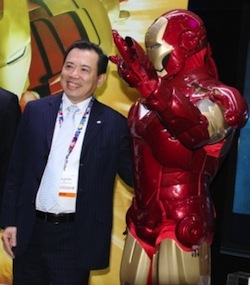
Alongside that, the company also showed its MoVo with Google TV 3.0 sets, said to combine its 'manufacturing expertise and newly introduced Personal Box Office (PBO) technology, Marvell Semiconductor’s cutting-edge SoC design technology as well as Google’s advanced search engine.'
This will enable it 'to offer a highly intelligent system that is designed to recognise individual preferences and automatically recommend the best match content for the right user at right time.'
According to Li Dong Sheng, TCL Chairman and CEO (seen left with Iron Man) puts it, 'Moving forward, we will continue to focus on our globalization strategy and spare no efforts in providing worldwide consumers with the latest best quality electronic products with richest experiences.'
The company says that it 'has achieved 15.2 million TV sets in annual sales volume, following closely behind Samsung and LG to set a new benchmark for the fast-rising China enterprises and signify TCL officially steps into the first camp of global TV industry.'
On this showing, who'd argue with Chinese companies such as Haier, Hisense and TCLnot just keeping pace with current market leaders LG and Sasmung, but reeling them in and overtaking in very short order.
After all, Hisense says it plans to be in the top three global TV manufacturers within the next two years.
So, while old-school TV leaders like Panasonic and Sony have their eyes firmly fixed on catching up with the new leaders of the market, they might well want to take a look over their shoulders: the Chinese brands aren't just coming – they're here.
And if their achievements to date are enough to make the Korean market-leaders wary, the Japanese brands once dominant in this market should be even more scared right now.
Serious R&D investment
After all, the big Korean companies have got where they are today not just by aggressive sales policies, but by major investments in R&D: Samsung has a massive research establishment, as I found when I visited a few years back – and it's got even bigger since!.
Meanwhile LG has just announced a major R&D investment for 2013, setting aside some KRW6tn (£3.5bn) to develop new technologies and products as part of a total investment this year of some KRW18tn (£10.5bn).
And the Chinese? Well, Hisense has just begun construction on what it calls 'the world's largest R&D base' in Qingdao. Designed to satisfy the company's needs for the next three decades, the new 430 acre facility will replace the current 50 acre site (below), which 'cannot meet the demand of Hisense’s R&D and rapid growth'.
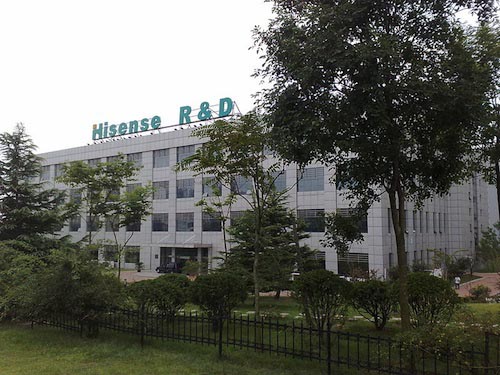
It's planned that the new facility will take on tens of thousands of employees, and 'be a future technological hub for technology, information, and research', designed to be 'the world's most advanced and innovative research and development center'.
The intention is that 'Qingdao will be the most important R&D center for multimedia display technology not only in China, but also globally'.
Now, anyone still labouring under the misapprehension that the Chinese TV industry is just a dim and distant threat…?
Click here for all our coverage from CES 2013
Andrew has written about audio and video products for the past 20+ years, and been a consumer journalist for more than 30 years, starting his career on camera magazines. Andrew has contributed to titles including What Hi-Fi?, Gramophone, Jazzwise and Hi-Fi Critic, Hi-Fi News & Record Review and Hi-Fi Choice. I’ve also written for a number of non-specialist and overseas magazines.
